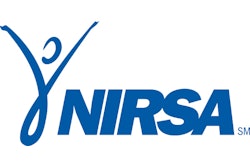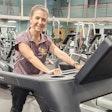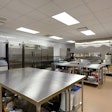As the first baby boomers celebrate their 56th birthdays, programmers and designers of community recreation centers find themselves at a crossroads.

Nineteen-forty-six was quite a year. Beyond the challenges that lay ahead in the post-World War II era, a number of historical events took place - 3.3 million of them, in fact. That was the number of Americans born in the first year of what would become known as the "baby boom" generation. The baby boom continued through 1964, increasing America's population by 76 million in just 18 years.
This year, the first boomers are turning 56 years old, putting one foot squarely into their senior years. As the rest of the baby boom generation looms on the horizon, ready to join the senior community, programmers and designers of community recreation centers find themselves at a crossroads. Will the boomers bring a revolution to senior programs? If so, will one revolution require another in the design of community recreation centers. In 15 years, will the "senior center" of today be a thing of the past?
Often, design parameters are reactions to the current situation. In the case of a senior center, it often means understanding the demographics of a community's seniors - their interests, activities, cultures and needs. But since buildings have a life of at least 40 years, how can they be designed to meet today's needs while remaining adaptable to tomorrow's needs? And since the current generation of seniors will remain the primary users of senior-oriented programs and facilities for the next decade, how do we both plan for the future while accommodating current seniors' needs?
The core of today's senior center users were born during the 1920s and '30s. For many of them, their life experiences, ranging from the Roaring '20s to the Great Depression and then World War II, defined their personalities and beliefs. Their generation feels incredible common bonds wrought by the changes the world underwent during their youth. As Tom Brokaw wrote in The Greatest Generation, "This generation was united, not only by a common purpose, but also by common values, duty, honor, economy, courage, service, love of family and country, and above all, responsibility for one's self." This generation was also focused on stability. Often, a career path was focused within a single company and aimed at the rewards of retirement. Today's senior programming is defined directly by those goals or rewards - and so is design.
Multigenerational centers - interestingly, even those that serve two distinct senior populations - are more complicated to design and program. A 12-year-old recreation/senior center in Louisville, Colo., that is currently being expanded bears this out. The seniors there have expressed themes common throughout the country. Although they are more than willing to share spaces with other users when they are not present, they want spaces that they can call their own. They also want a separate entry and a home base that provides familiar, comfortable surroundings. Still, they recognize and appreciate the diversity of interests within the senior community and believe that diverse needs should be accommodated, whether they are activity-focused, education-focused or socially focused.
Senior facility design has, for the most part, followed a model begun in the 1960s and '70s, as this current generation of seniors began to develop a set of interests and needs as they gained financial independence prior to retirement. Multifunctional meeting or social spaces have been, and remain, the core components of most senior centers. These rooms must adapt from card rooms to lunch rooms to dance halls during the course of a single day. The senior programs hosted in these multipurpose spaces are often supported by other spaces that may be tailored to more specific types of activities. Arts and crafts rooms (both wet and dry), billiards rooms and lounges have added greater diversity to the design of senior centers, but they consistently reflect the seniors' tendency toward group activities.
During the past 10 to 15 years, a prominent development in senior programming and facility design has taken place. Like Louisville did in 1990, many communities have begun to build community recreation centers. These facilities have quickly evolved from a simple building with a gym and a lap pool to large complexes welcoming multiple generations and types of users. Wildly fun pool environments, vast fitness centers, specialized activities such as rock climbing and group cycling, classrooms and community rooms, and support services such as day care have become commonplace. Integrating senior programming into the complex has also become commonplace; integrating facility spaces has not. This recent recreation/ senior center prototype typically devotes dedicated areas to the senior population, separated from the more active recreational or youth-oriented components.
While meal programs and social activities such as billiards and card games remain core programs, new trends have emerged. Community recreation centers have exposed professional programmers and the public to activities that can be incredibly beneficial to the senior community. Fitness and exercise activities, wellness programs and specialized water aerobics classes have become new hits among senior center users. Additionally, the missions of senior centers have been broadened with the expansion of educational programs and offsite activities. These new activities (plus a similar explosion in online activities) point to a transitional generation that is giving us a sign of things to come as the boomers approach their senior years.
These changes have been reflected in building design, as well. Over the past decade, senior/community centers have begun to include specialized spaces such as computer classrooms, therapy pools, fitness centers, libraries, specialized classrooms or studio spaces (woodworking, stained glass, pottery and so on), and active recreation areas such as gymnasiums and pools. Another significant change has been the movement toward a less institutional, friendlier atmosphere. Fireplaces, sitting areas and lounges have taken their place front and center, echoing a new "Welcome home!" approach to design. While stand-alone senior centers continue to be built, they often integrate many of the components more typically found in a community recreation center.
Although it is always difficult to make reliable predictions about the future, understanding the baby boom generation may help to give insights into the changes needed in senior center design.
While the current generation of seniors is rooted in stability, the baby boomers have known plenty of change. The boomers grew up amid the generational turmoil spanning the late 1950s to early '70s, and developed into perhaps the most demanding (and impatient) consumer society ever. Translated for many baby boomers today, it means a life of SUVs, cell phones, corporate relocations, independence, entertainment, travel and recreation, and the familiarity of franchise food and retail stores. Within the fitness and recreation industry, this generation demands more from their fitness or recreation experience through personalized services such as personal trainers, day care, babysitting and massage therapy. In addition, boomers are definitely not convinced that retiring to some warm, sunny place to play golf and watch someone else cut their lawn is the answer to graceful aging. Baby boomers view retirement as a new, promising chapter in life.
In a recent survey of adults age 18 and older, the American Association of Retired Persons notes that a new attitude about aging is emerging. Ninety percent of today's adults believe they can partly control how they age, primarily through physical activity. (Secondary methods to control aging include nutrition, watching one's weight and maintaining a positive attitude.) Survey respondents said they expect to live longer, are more likely than those who don't to be doing something now that they think will help them stay active and healthy as they grow older, and are more optimistic about the benefits of weightlifting for persons over 80 years old. Fifty-six percent of the respondents believe that, although limited in what they can do compared to younger adults, the average 80-year-old will be healthier in 2050 than today.
For the adults surveyed, being "old" is usually associated with physical or mental problems or limitations. On average, the survey respondents felt a person is considered "old" at 69. This perception may be consistent with the existence of a transitional generation (ages 55 to 70) that is now beginning to have an impact on senior-center programming. This group is much more active than the over-70 generation. Following in the footsteps of this transitional generation, baby boomers, just by their sheer numbers, will have a major impact as they mature.
How will these changing attitudes and interests influence senior facility design? Let's focus first on the mental aspects for this new generation of seniors. First, programmers and designers must think integration, welcoming senior users as part of a broader, multigenerational community recreation center. Although this may mean eliminating physical and perceptual barriers, it may also mean special accommodations for seniors through personal trainers, specialized equipment or instruction targeted to specific needs. The key will be to provide these specialized, age-driven services in an environment that looks and feels multigenerational.
A separate entry for a senior center may no longer be appropriate. In fact, the term "senior center" may no longer be appropriate. Perhaps the concept of a straightforward "community center" may be the best sales tool available to convince these new, active, age-conscious seniors to walk through the doors.
Second, recreation professionals will have to support the idea that a large part of productive aging is mental well-being. Baby boomers' expectations of life after their career may be much the same as those before a career - classrooms, arts, a library, a student union and entertainment, as well as recreation. New community centers targeted to the senior population should provide the right tools to nurture mental well-being. Much of this will come from programming centered on personal or spiritual growth, education and volunteerism. Design can reinforce these ideals by providing inviting settings, integrating daylight and color, and providing the infrastructure and flexibility to accommodate a full range of uses.
Third, programmers will have to recognize that generation gaps or cultural differences will continue to exist. Not all seniors will be outgoing, physically capable of recreating in the same ways as the rest of the community, or interested in mixing with younger people with unfamiliar interests. For these seniors, a comfortable, friendly and dedicated home base will have to be provided that is tailored to match their expectations. Focus on the quality of the space through furnishings, materials, aesthetics and activities such as watching television or surfing the Internet. Be willing to update it frequently to match boomers' penchant for new and improving aspects of life. The home base needs to be "cool."
Fourth, recreation professionals will have to recognize that, even with wonderful strides in medicine, age still takes its toll on the body and mind. This means that many of the challenges faced by today's seniors will eventually confront newer, healthier generations of users. The design of a facility cannot overlook the physical and mental challenges of its users.
Physical disabilities can vary widely. Sight and hearing impairments, muscular deterioration, arthritis, osteoporosis and varying degrees of paralysis often accompany age. While guidelines developed as part of the Americans with Disabilities Act are a good basis for design, every detail of design must be developed with consideration for these disabilities. Simultaneously, though, it will be important to integrate the details in a way that avoids the perception of institutional environments geared toward seniors. Good lighting, and specifically great acoustics, will be especially appreciated by this group. Locker rooms with ample benches, good clearances between benches and clear circulation will complement the use of fitness or recreation areas. Equipment selection will need to be conscious of the visibility of controls and information panels. Utilization of some innovative products - lower-resistance treadmills, aluminum bars for free weights, and less intimidating exercise elements such as fitness balls - will have to be considered.
As seniors age and some begin to experience lapses in memory, set times and structures for programming also become helpful. Quiet spaces that allow seniors to focus and learn at their own pace are critical. Distinctive colors, architectural landmarks and legible signage are subtle ways to accommodate the aging process without drawing attention to it.
Above all, designers mustn't forget the lessons learned in the design of today's senior center environments. Covered entries with comfortable waiting areas (whether inside or outside) should be incorporated, and parking areas and public transportation stops should be located close by, with ample space provided for pickup and dropoff from buses or vans. Primary activity spaces must be easy to access. Rest rooms should be located adjacent to the lobby and near multipurpose rooms. More plumbing fixtures should be provided for women than men. Heating and air conditioning systems should be separately zoned in spaces frequently used by groups of seniors, and sized to be quickly responsive to needed temperature changes.
Finally, facility planners must remember that everything changes. How can these guiding principles for design of senior centers be applied in the near future and still fulfill the needs of the current generation of seniors? Flexibility must be built in. Recreation professionals must work with their architects to help forecast the types of programming likely to occur in their facilities. Many senior centers are currently dealing with these issues through scheduling that naturally bridges the gap between older seniors and younger seniors. Traditional seniors are using facilities during the daytime, while younger seniors, many of whom may still work, dominate programming in the late afternoon or early evening.
The human spirit, social interaction, friendly competition and shared experiences are consistent aspects of American life. Yet, as the landscape of the generations changes, so do people's needs - and recreation and fitness providers must be ready to customize their services, re-educate their staffs and rethink the way their classes are taught. Architects must be creative in developing environments that are multigenerational, yet sensitive to the differences in needs (functional and aesthetic) from one user group to the next - all with future flexibility in mind.
Remember, the Gen Xers aren't all that far behind.




































